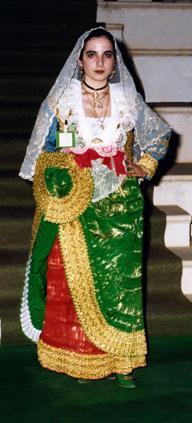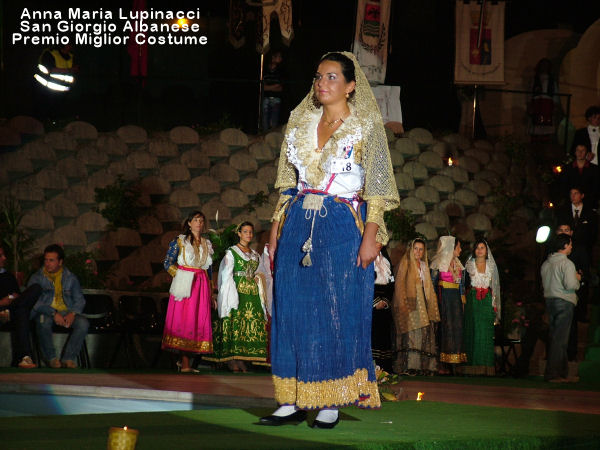Hello all,
Today I would like to start talking about the costumes of the people known as Arbëreshë, or Italo Albanesi, although the Italians sometimes call them Greci. These are Albanian speaking people that inhabit southern Italy, in scattered villages from Sicily up to Abruzzo, with the largest concentration being in Calabria.
https://en.wikipedia.org/wiki/Arb%C3%ABresh%C3%AB_people
These settlements started in 1448, when the King of Naples, Alfonso V granted land to Albanian Mercenaries to settle on. When the Kingdom of Albania ruled by Skanderberg fell to the Ottomans, more Albanian settlers came to Italy. These continued in various waves over the centuries. These colonists have retained much of their folk tradition in language, music, costume, and especially religion, as most of them are members of the Albanian Eastern Catholic Church. Currently there are about 50 communities which consider themselves to be Arbëreshë.
The costumes, which vary from village to village, and which have not been preserved in all, are derived mainly from old Italian costume, as most of them do not resemble those found in Albania at all. As Italians have mostly stopped wearing their traditional costumes, it is difficult to say how much the Arbëreshë costumes differ. Only the women have preserved these costumes, when men or boys wish to dress in costume, they borrow a form from Albania.
Although the costumes vary from village to village, they do form coherent groups, and I will present each of these groups. Each village, of course, has at least two names, I will list the Arbëreshë name first, followed by the Italian name. Often the name in the local Italian dialect is different from that in standard Italian
Spixan or Spezzano
This costume region lies in the Province of Cosenza, Paese of Calabria near the Sila National Park. It includes the town of Spixan or Spezzano Albanese itself, and also 5 villages which lie to the south in a line from Shën Sofia e Epirit, (Santa Sofia d'Epiro) east to Mbuzati, (San Giorgio Albanese). These also include Shën Mitri or San Demetrio Corone, Strigàri or San Cosmo Albanese, and Vakarici or Vaccarizzo Albanese. The following maps should help with location.
The image at the head of this article shows this costume on the right, and that from the Piani Albanesi in Sicily on the left. I will first describe the gala costume worn for weddings and great occasions, which is called llambadhor.
At the waist is a small, gold embroidered ornament called palandrelja, which is secured by straps attached at the waist through the pocket holes. This may possibly be a vestigial apron.
In S Giorgio and Vaccarizzo, sometimes an apron takes the place of the top skirt. This is often of silk and richly embroidered. This is considered to be a less formal version. When an apron is worn, the palandrelja is not.
A short jacket, xhipuni, is worn with the gala costume. This does not close in front, and usually does not reach the waist. It is ornamented with gold galloon on the wrists and the back. The sleeves are often richly embroidered in gold. The jacket often matches the overskirt, and thus is usually green, blue or violet. It may occasionally be black. In the case where an apron is worn instead of the overskirt, it may be red. See the various photos in this article.
The hair is put up into a bun and a bun cover, keza, is worn over it. For girls and younger women, the hair may be elaborately braided with ribbons. Rich jewelry is worn with this outfit, shoes may be of black leather with white stockings, or may be made of a color that matches the overskirt with sparkling embroidery, as we see in this image above.
The 'half festive' costume resembles this one, but with less elaborately ornamented materials. The overskirt is often not worn, and when it is, it is of a plain color, the underskirt is either red, or red with a deep green border. The jacket is black, and an apron is worn. A petticoat is still worn, and the chemise is similar, but without the elaborate lace. The petin is still worn under it. In this first image, the festive costume is on the left, and the everyday is on the right.


.png)
.jpg)
.jpg)






















0.jpg)

























01.jpg)










05.png)





















01.jpg)







0.jpg)
02.jpg)



.jpg)
I'm interested in the folk costumes of the Sami people of Lapland. I'd like to learn as much as I can about the different designs are really cool.
ReplyDeleteThere is a search function on my blog. I have written articles on many subjects, including that one. https://folkcostume.blogspot.com/2013/05/overview-of-saami-costume.html
Deleteabsolutely beautiful costumes & article. i was wondering whether you have any book recommendations or other sources on specifically upper austrian folk costumes? alternatively, i would love to read a post in your usual style (with different regions, etc.) about it if you have the time. thank you & great work!
ReplyDeleteI have not as yet had a chance to write on that. Upper Austria had not preserved their costumes as well as some other parts of the country
DeleteIn what period were these costumes worn? Nineteenth century?
ReplyDeleteThank you so much for taking the time for you personally to share such a nice info. I definitely enjoying.
ReplyDeleteOnline Classes
ıldır transfer
ReplyDeletegüzelbahçe transfer
foça transfer
mordoğan transfer
aliağa transfer
MXL5
Have you done Styria in Austria? If not, I'd love to see how it compares to your previous posts on Austria!
ReplyDeleteHello, I think one of this Women is my mother 😂 can I have the reference for the 10th photo, after “ It is very common to see girls posing with the top skirt lifted so as to show the underskirt.”
ReplyDeleteThanks in advance!
Je ne saurais trop vous remercier pour cet article de blog. Je continuerai à lire...
ReplyDelete